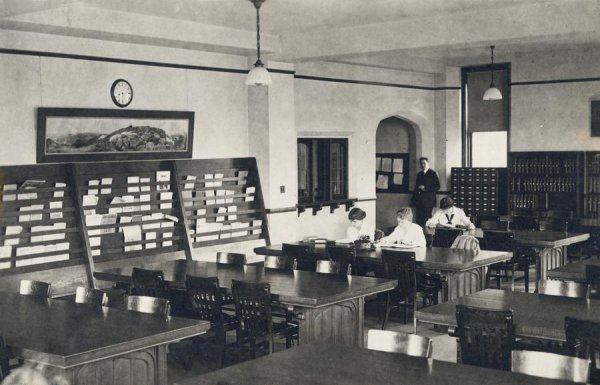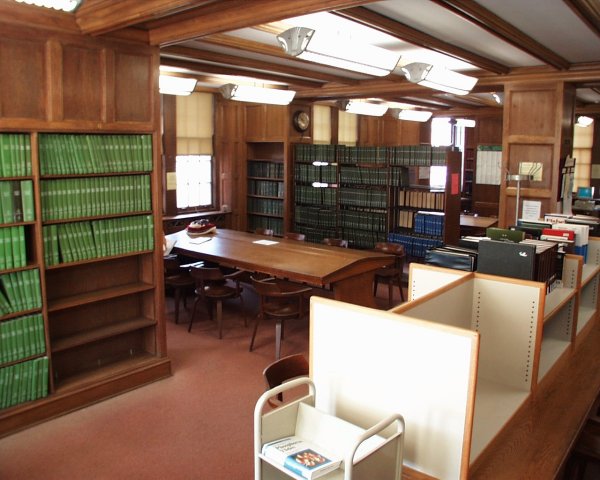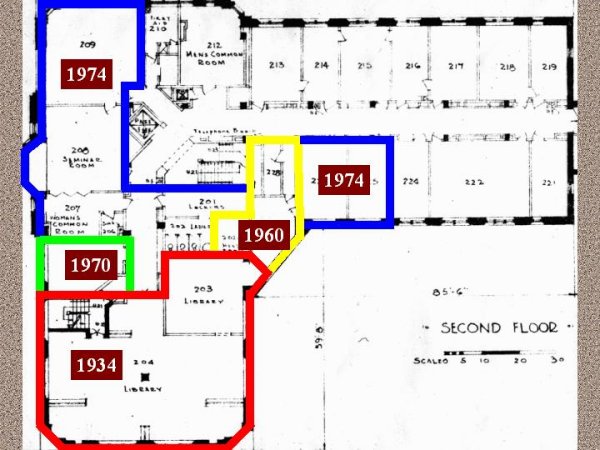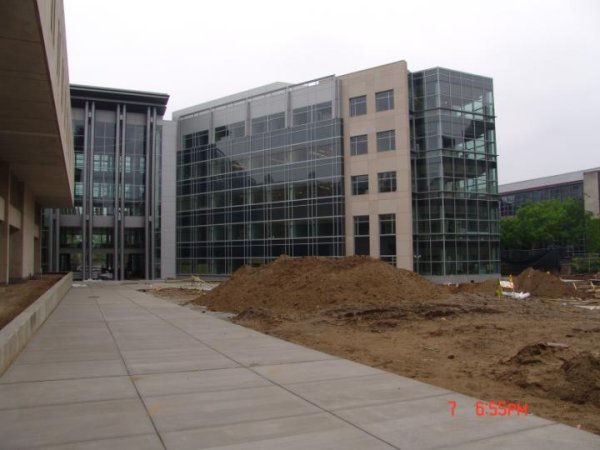| URLs in this document have been updated. Links enclosed in {curly brackets} have been changed. If a replacement link was located, the new URL was added and the link is active; if a new site could not be identified, the broken link was removed. |
A Century of Progress? Adaptation of the Chemistry Library at the University of Chicago
Bibliographer for Chemistry, Physics, Geophysical Sciences, and Technology
John Crerar Library
University of Chicago
atbrooks@uchicago.edu
Abstract
During its nearly 100-year history, the Chemistry Library at the University of Chicago and its librarians have responded to changes in the university and in society, including changes in the practice of librarianship, scientific publishing, chemical research, and higher education. A century of discussion about the benefits and shortcomings of departmental libraries has also appeared in the library literature. A review of this literature highlighted a set of issues that influence organizations in their decisions to support departmental libraries or to consolidate these branch libraries into centralized facilities. In the case of the University of Chicago's Chemistry Library, the relative importance of these various issues changed over time, and led to periodic changes in library services, physical facilities, and collection practices. Eventually, the traditional departmental library model gave way to changes in the institution and in scholarly publishing, creating a "tipping point" which led to the current centralization of the collections and services.
Introduction
Academic research institutions often have a number of departmental libraries, as well as one or more "centralized" or "consolidated" campus libraries to serve faculty, students, and other library researchers. The University of Chicago has had both types of libraries at various points during its more than 100-year history. During the first half of the twentieth century, the campus was served exclusively by small departmental "reading rooms" which were located in various buildings.

Rosenwald Hall (Geology) reading room circa 1915
(Credit: Archival Photofiles, [apf2-07112], Special Collections Research Center, University of Chicago Library.)
In 1970, departmental libraries in the humanities and social sciences were mostly consolidated into a large central library (Joseph Regenstein Library), although the internal arrangement of this centralized library mimicked the "reading room" concept, with distributed discipline-specific reference and circulating collections on each of the five floors (e.g., religion/divinity books, journals, and reference works were all located on the fourth floor). Most of the physical and biological sciences departmental libraries were also combined in the early 1980s into a centralized library (Swanson 1986), the John Crerar Library for science, medicine, and technology. However, the Chemistry Library at the University of Chicago continued to exist as a separate departmental library another two decades. The reasons both for this long existence of a departmental library and its eventual consolidation into a centralized science library will be examined.
A number of issues or characteristics that favor either departmental libraries or favor centralized libraries were identified by a review of the literature (Shkolnik 1991; Shoham 1982; Jurkowski 1998; Seal 1986; Lessin 2001; Hurd 1996; Suozzi & Kerbel 1992; Roberts et al. 1991; Dodd et al. 2000; Dekeyser 1998; American Library Association 1990). Characteristics which favored the existence of departmental libraries included proximity to research laboratories (often in the same building), familiarity with the subject specialist librarian, special facilities for access (e.g., 24 hour key entry), professional independence for the subject specialist librarian, customized services for primary users, operational flexibility, and small size (convenient and easy to navigate). On the other hand, issues or factors that supported centralized library facilities included comprehensive and unified collections (especially convenient for non-primary users), increased desktop availability of electronic resources , collegial atmosphere for subject specialist librarian, economies of scale (no duplication of collections, fewer staff, etc.), more space (including more flexibility for arranging collections), increases in interdisciplinary research, more hours of access for non-primary users, better environmental conditions for collections and users, and greater security for collections. Over time, these issues waxed or waned in importance relative to each other. Library users changed their use of the library, while the librarians adapted the library operations and facilities to the user.
Centralized Science Library or Departmental Chemistry Library?
Traditionally, the chemists have been strong supporters of the departmental library model. The first chemistry reading room at the University of Chicago was in Kent Chemical Laboratory, which was one of the first buildings constructed on the campus. It was eventually replaced by the Chemistry Library in a new chemistry building, the George Herbert Jones Laboratory.

Chemistry Library main reading room
When the building opened in 1934, the oak paneled facility covered about 3000 square feet, contained book and journals collections in chemical sciences, and was staffed by a full time librarian and part time student staff. Over the next seventy years, this library faced a number of challenges that relate to the various issues identified in the literature review. Three areas in particular will be examined: space, collection maintenance and usability issues, and interdisciplinarity of research.
Space, space, and more space...
Like all libraries, the Chemistry Library never seemed to have enough space. Just three years after it opened, the head librarian reported that "our shelves are becoming filled rapidly"(Tippet 1934). This was a common refrain in throughout the years. The most unusual action taken by a librarian to create more space for users, as well as for collections, was to remove a piano from the reading room to make space for a table and eight chairs (Soule 1967). Space in an attic area of the building was used for storage of unprocessed gift and other collections, but this space was eventually abandoned since it was not environmentally appropriate for this use. Space concerns became critical in the late 1960's and early 1970's. The chemistry department gave a couple of additional rooms to the library in 1960 and 1970 for the creation of staff office space and additional journal shelving. In 1974, the Chemistry Library was granted substantial additional space for expansion, and repurposed former classroom and office spaces to create a current periodicals reading room, a separate shelving area for monographs, and more bound journal shelving. This addition was possible because the construction of Searle Chemistry Laboratory (completed in 1968) created free space adjacent to the Chemistry Library. This space proved to be sufficient for only 10-20 additional years of growth, and by the 1980's space issues were again becoming critical. A floor plan of the Chemistry Library reflecting additions to the space is shown in Figure 1. The 1974 configuration remained in effect until 2003.

Floor plan for Chemistry Library 1934-2003
With the construction of the John Crerar Library for science, medicine, and technology in 1983, the scope of collections in the Chemistry Library was refocused. Research level materials in most core chemistry areas were retained, while more peripheral materials like course reserves and applied chemistry books and journals were transferred to the new science library. Even having taken this measure, by the mid-1990's the situation was again critical, with the library shelves at 95% capacity, and volumes being stored on the floor, under desks and tables, and even in a closet in an old kitchen area. The collection focus was then further narrowed to free up space for core materials. Subscriptions duplicated between Crerar and Chemistry (e.g., Physical Review Letters) were cancelled and copies withdrawn from Chemistry shelves. Inactive Russian translation titles and pre-1970 imprint monographs were transferred to the Crerar Library. Several current journal titles were transferred (particularly in physical chemistry and spectroscopy) and/or cancelled (cancellations were undertaken for financial reasons, not for space reasons). Between 1990 and 2000, more than 15,000 volumes were weeded or transferred out of the collection. Due to the number of volumes to be transferred, and a desire to minimize disruption to users of chemistry journals, a commercial library moving company was used to move the majority of the journal volumes transferred. This move was accomplished over a few days and at a total cost of $11,600. This project moved materials shelf to shelf, so only small additional library staff costs were incurred. Despite these actions, the collections continued to grow exponentially, primarily because of increased volume of publication in core chemistry journals located in the Chemistry Library. Both the number of papers and pages published in established journals and the number of new journals in core chemistry areas increased during this period. In 1910, the bound volumes of the previous ten years of publication of core journals in the chemistry collection occupied 32 linear feet of space on the shelves. By 1990, the previous ten years of core journals required 480 linear feet of space to house the volumes. Since 1940, the amount of space needed every decade had doubled. If the trend continued, by 2000 almost 1000 linear feet of shelving would be needed to house the previous decade's publishing output in core chemistry journals.
Collection maintenance and usability
Various collection maintenance and usability issues contributed over time to changes in the Chemistry Library. Departmental collections were often less secure and more prone to damage than centralized collections. A departmental chemistry library located in a research laboratory is even more vulnerable. The Chemistry Library at the University of Chicago was subject to numerous incidents of flooding from broken water pipes in wet laboratories on the floors above the library. Fumes from chemicals in the laboratories often permeated the building in the time before adequate ventilation systems were installed. The lack of central heating and air conditioning, as well as the lack of humidity controls created less than desirable environment for books and journals (as well as for library users and staff!) Users brought in food and drinks (especially during hours in which no staff were present), and the resulting crumbs and other debris attracted mice, cockroaches and other pests. Because the library had no anti-theft security in place, books and journals could be removed by users without charging them out. At the same time, the materials were some of the most heavily used materials in chemical sciences.
Accessibility and convenience to the Chemistry Library collections was excellent for most primary users of the collections (i.e., chemistry department faculty, graduate students, and research associates). These primary users had 24-hour key access to a small, easy to navigate library located (generally) in the same building as their laboratories and offices. (Several physical chemists were actually located in a different building, and consequently found the Chemistry Library somewhat less convenient, although they still had 24-hour key access). A departmental photocopier was available for making copies of journal articles and the cost charged back to a research account. However, the librarians received fairly regular complaints from other users of chemistry materials that the hours and location of the Chemistry Library were inconvenient. These users wished the chemistry collections to be moved to the John Crerar Library, where a comprehensive science collection would be centrally located for all science researchers. The chemists, of course, were strongly opposed, and resisted efforts to close the departmental library. However, changes in the nature of scholarly publishing that took place starting in the late 1990's were soon to alter attitudes of many of the users of chemistry literature.
The advent of desktop database systems for article discovery and the delivery of journal articles online created a major shift in the perception of the necessity of a departmental chemistry library. Usage of databases in chemistry like SciFinder Scholar and Beilstein/Gmelin CrossFire very quickly outstripped any previous usage of their print counterparts. Online journals were wildly popular almost from the moment of their introduction to the chemical community, and are now established as the primary means of access to the journal literature in chemistry. In 2004, the number of articles downloaded at the University of Chicago from the top 10 chemistry online journals represented almost 10% of the total measured downloads for ALL science online journals. The University of Chicago Library has adopted a very aggressive program to obtain online journals in chemistry, including any available backfiles. The increase in online journal usage was accompanied by a concomitant decrease both of in-house bound journal usage and regular circulation from the collection. The overwhelming preference for online versions over print journal publications greatly reduced the need for a departmental library collection of core journal titles and eroded the resistance to the idea of centralizing the collections into the main science library.
Interdisciplinarity of research
The University of Chicago has a long history of interdisciplinary research, as reflected in its organization not only into departments, but into various institutes, academic committees, and centers. The Department of Chemistry states the following on its research web page: "The Chemistry Department strongly encourages interdisciplinary research. The following institutes, both on-campus and off, enable the interaction of our community with its counterparts in physics, biological sciences, geophysical sciences, astronomy and mathematics, thereby promoting wide-ranging cross-disciplinary studies. Argonne National Laboratory (ANL), Ben May Institute for Cancer Research , Enrico Fermi Institute (EFI), Howard Hughes Medical Institute, James Franck Institute (JFI), Materials Research Science and Engineering Center (MRSEC), and The Institute for Biophysical Dynamics (IBD) " This tradition of interdisciplinary research continues with the recently completed construction of the Center for Integrated Science (CIS) which was also previously known as the {Interdivisional Research Building.} This 430,000 square foot facility was created at a total cost of about $200 million and took four years to complete. The facility houses about 80 senior scientists in cross-disciplinary fields in chemistry, physics, biology, and medicine, along with about 700 students and research associates. It houses researchers in the Institute for Biophysical Dynamics, the Howard Hughes Medical Institute, the Ben May Institute for Cancer Research, and the James Franck Institute. A significant portion of research groups in the Department of Chemistry are among those located in this facility. The CIS is located immediately to north and west of the John Crerar Library.

The Center for Integrated Science (right) was constructed immediately adjacent to the John Crerar Library (left)
The proximity of the John Crerar Library to a large portion of the chemistry research community, as well as the convenience of a comprehensive, unified science collection contributed toward the acceptance of a consolidated library and the closing of the Chemistry Library.
Closing the Chemistry Library
In March 2003, the University of Chicago Library Director held discussions with the Dean of Physical Sciences and the Provost of the University. about the future of the Chemistry Library. Subsequent conversations took place among the incoming and outgoing chairs of the Department of Chemistry, the head of the Science Libraries Division, the Chemistry Librarian, and various faculty and graduate students of the department. While complete consensus on the issue was not reached, it was determined that the Chemistry Library would close as a service point, and the collections would merge with those of the John Crerar Library. In an historical context of the previous decade's multiple weedings and transfers, this decision to close the Chemistry Library can be viewed as an evolutionary step, rather than a sudden change. To accommodate concerns of chemistry faculty and graduate students, the closure was organized in several phases.
In the first phase during September 2003, the circulating book collections, portions of the reference collections, all unbound journal issues, and all bound journal volumes, excepting 12 core chemistry titles (those without online backfiles) were transferred to the John Crerar Library. These materials were integrated into the collections there. The materials that remained behind (a small reference collection and the 12 journal titles)in the Chemistry Library were consolidated and shifted into the original 1934 reading room. Three networked computer workstations and the Department of Chemistry photocopier also remained. It was expected that the materials and equipment would remain there until the new CIS building was completed (sometime in 2005). A commercial library moving service was used, at a total cost of about $10,000.
However, the Division of Physical Sciences (the administrative unit in which the Department of Chemistry is located) determined that the reading room space was needed for other purposes. After consultation with the Department of Chemistry administrative staff and the Dean's office, the decision was made to transfer the bound journal volumes still in the Chemistry Library to the John Crerar Library, and to consolidate the reference collection and equipment into a smaller, nearby room (the former circulating monograph room of the library). The Dean's office paid for the services of the library moving company, and the move was completed in December 2003. The move of the journals to Crerar was made more palatable by the January 2004 acquisition of online backfiles for most (Angewandte Chemie International Edition in English and the Royal Society of Chemistry titles), if not all, of the titles that had been left behind in the September move.
The final phase of the closing will take place in in late 2005 (or at worst during early 2006). Fewer than 200 linear feet of material remain in the George Herbert Jones Laboratory reading room. These materials are almost entirely reference books and sets. The library has been concentrating on recent efforts to acquire as much online access to chemistry reference materials as feasible. Between December 2003 and September 2005, licenses to Knovel e-book collections in chemistry, safety, and biology and SpecInfo (a database of IR and NMR spectra) were signed. Other e-book and e-reference resources are currently under active consideration, including standard reference titles like Organic Reactions, Merck Index, and various encyclopedias and handbooks. The availability of chemistry reference resources at desktops in laboratories and offices, as well as from off campus is an important goal for the Library.
Sweetening a bitter pill?
The closing of the Chemistry Library at the University of Chicago should be seen in the context of evolutionary change, and not as a decision taken either suddenly or lightly. Changes in user behavior, the teaching and research environment of the university, materials preservation and security, direct and indirect costs of library operations, the astounding development of online and web based information resources, and the changing nature of scholarly publishing were all factors considered in making this decision. This decision was made possible by regular, honest, and open communication between library staff and the community of users. Library collection activities which served to smooth the way for closing included aggressive acquisition of electronic journals (both current subscriptions and backfiles), desktop availability of chemical information discovery tools (like SciFinder Scholar and Beilstein/Gmelin CrossFire), staged relocation of materials to minimize user disruption, improvement of cataloging records for serials (print holdings and online access information) and continued addition of online chemical reference and e-book titles. Institutional and environmental factors that allowed (and in some cases supported) the consolidation of science materials into a centralized collection were the strong emphasis on interdisciplinary research, construction of a research building housing many of the University's chemistry groups adjacent to the central science library, and enthusiastic acceptance of electronic versions of chemical information resources by faculty, students, and research staff.
References
American Library Association. 1990. Guidelines for Branch Libraries in Colleges and Universities. American Library Association [Online]. Available: {http://www.ala.org/ala/acrl/acrlstandards/guidelinesbranch.htm} [Accessed 03 Jun, 2005].Dekeyser, R. 1998. Arguments for Library Centralization in the Digital Era. presented at Programme on Educational Building, OECD Experts' Meeting on Libraries and Resource Centers for Tertiary Education. Paris, France: OECD. [Online]. Available: http://www.oecd.org/dataoecd/17/22/2004144.pdf [Accessed October 20, 2005].
Dodd, J., et al. 2000. Renovating science branch libraries: Two different paths. Science & Technology Libraries 19 (1):39-47.
Hurd, J. M. 1996. ARL academic science and technology libraries: report of a survey. 1993-1994; conducted by the ACRL Science and Technology Section. College & Research Libraries 57:144-5.
Jurkowski, O. L. 1998. The evolution of academic branch libraries. Illinois Libraries 80 (1):27-8.
Lessin, B. A. 2001. Merging Science/Technology Libraries: A Valuable Planning Option. Science & Technology Libraries 21 (1/2):3-15.
Roberts, E. P., et al. 1991. Physical structure and administration of science and technology libraries: an historical survey. centralized vs departmental academic science libraries. Science & Technology Libraries 11:91-105.
Seal, R. A. 1986. Academic branch libraries. In Advances in librarianship, pp. 175-209. United States: Academic Press.
Shkolnik, L. 1991. The Continuing Debate over Academic Branch Libraries. College and Research Libraries 52 (4):343-51.
Shoham, S. 1982. A Cost-Preference Study of the Decentralization of Academic Library Services. Library Research 4 (2):175-94.
Soule, S. G. 1967 Chemistry Library Annual Report. University of Chicago Library (unpublished report).
Suozzi, P. A. & Kerbel, S. S. 1992. The organizational misfits. departmental libraries. College & Research Libraries 53:513-22.
Swanson, P. A. 1986. The John Crerar Library of the University of Chicago. Science & Technology Libraries 7:31-43.
Tippet, M. M. 1934. Chemistry Library Annual Report. University of Chicago Library (unpublished report).
| Previous | Contents | Next |
